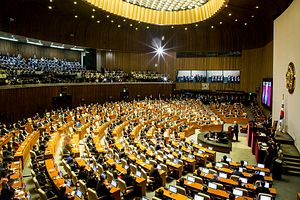U.S. President Donald Trump’s inaugural trip to South Korea — the first “state visit” by a U.S. president since George H.W. Bush — could have gone worse. Expectations were low going in, but Trump mostly kept to the script, avoiding the sort of bellicosity that might further sour an already tense and dangerous relationship with North Korea and any acrimony toward the U.S.-South Korea Free Trade Agreement (KORUS).
Trump’s much-anticipated speech to South Korea’s National Assembly included a somewhat strange recounting of South Korea’s own history and economic “miracle,” but its approach to the North Korean question was undeniably familiar. With a focus primarily on human rights and dignity, Trump painted the two sides of the 38th parallel on the Korean peninsula as divided between freedom and oppression.
Instead of baiting Kim Jong-un or belittling him as the “rocket man,” Trump reverted to a deterrent threat: “The weapons you are acquiring are not making you safer; they are putting your regime in grave danger,” Trump remarked. “Do not try us,” he punctuated, implicitly offering the same kind of retaliatory threat his predecessors used against North Korea.
Critically, Trump broke from his pre-Asia-trip threats to send “fire and fury” and “totally destroy” North Korea. Lowering the temperature, he made an offer on his first day in South Korea: “It makes sense for North Korea to come to the table and make a deal that is good for the people of North Korea and for the world.” He calibrated that the next day at the National Assembly, demonstrating that the now-stale formula of insisting on denuclearization remained:
Yet despite every crime you have committed against God and man, you are ready to offer — and we will do that — we will offer a path to a much better future. It begins with an end to the aggression of your regime, a stop to your development of ballistic missiles, and complete, verifiable, and total denuclearization.
The positives of all this are apparent: the temperature on the peninsula is noticeably lower than it was in August and September. North Korea, too, allowed Trump to come and go from the Korean Peninsula without carrying out a ballistic missile test — which would have been a clear signal that Pyongyang isn’t interested in talking.
Trump’s words restored a degree of familiar equilibrium to U.S. North Korea policy — even if ultimately ineffective — at a time when the Washington DC-based political establishment seems to be growing more comfortable with the prospect of a U.S. first strike on North Korea. (An event that would, with little doubt, spark a nuclear war.)
Consider that as Trump arrived in Seoul, Admiral Dennis Blair, a former Director of National Intelligence and U.S. Pacific Commander, advocated a conventional U.S. strike on “all known DPRK nuclear test facilities” if North Korea went ahead with its threat to detonate a nuclear weapon over the Pacific Ocean. He even suggested that South Korea and Japan prepare their citizens for “civil defense” — the insinuation being that avoiding North Korean nuclear retaliation, at least in-theater, was far from a guarantee.
While Trump’s words in South Korea restore a degree of familiarity to U.S. policy that will be recognizable in North and South Korea alike, it does bring U.S. policy back to square one. “Maximum pressure” will continue with Trump’s efforts to expand sanctions against Pyongyang and to improve their implementation (especially in China), but the offer that U.S. Secretary of State Rex Tillerson and Secretary of Defense Jim Mattis had outlined in August — possible talks on the basis of a missile testing moratorium — has fully evaporated.
All this brings matters with North Korea to well-trodden territory. The United States will muddle along for now, with the specter of a first strike lower now than it was before Trump flew to Asia. (Yes, three U.S. aircraft carriers will nonetheless go ahead with exercises this week.) For Moon and South Korea, the visit will be regarded as a success. Trump showed up, stuck to the script on allied reassurance, and gave Seoul a major deliverable in the form of the Revised Missile Guidelines, which allow it to develop missiles with larger payloads.
Unfortunately, none of this will stop North Korea’s march toward an operational and mass-produced intercontinental-range ballistic missile and, soon enough, larger and better solid-fuel missiles. Sanctions may yield the benefits the administration seeks and bring North Korea to its knees yet, but the timeframe of such a result remains indeterminate. And so, we muddle on.

































